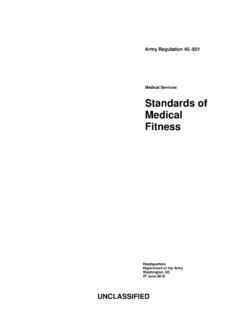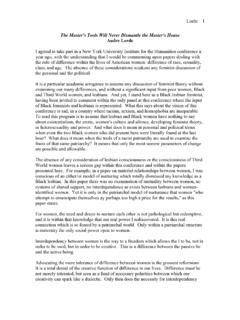Transcription of SURVIVAL MANUAL
1 SURVIVAL MANUALWINTER 2002 UNITED STATES MARINE CORPSM ountain Warfare Training CenterBridgeport, California 93517-5001 WINTER SURVIVAL COURSE HANDBOOKTABLE OF CONTENTSCHAP CONTENTS 1 REQUIREMENTS FOR SURVIVAL2 SURVIVAL KIT 3 WATER PROCUREMENT4 EXPEDIENT SHELTERS AND FIRES5 CORE VALUES AND MOUNTAIN LEADERSHIP CHALLENGES6 SURVIVAL SIGNALING AND RECOVERY7 SURVIVAL NAVIGATION8 TRAPS AND SNARES9 USES FOR GAME10 SURVIVAL FISHING11 FIELD EXPEDIENT TOOLS, WEAPONS, AND EQUIPMENT12 EXPEDIENT SNOWSHOES13 WINTER TRACKING14 SURVIVAL MEDICINE15 WEATHER16 INTRO TO EVASION17 AVALANCHE AND ICE HAZARDSAPPENDIXAEVASION PLAN OF ACTION FORMATB THE EDGE GUIDED DISCUSSIONCSURVIVAL QUICK REFERENCE CHECKLISTDANIMAL HABITSETACTICAL CONSIDERATIONSFGRADING STANDARDSUNITED STATES MARINE CORPSM ountain Warfare Training CenterBridgeport, California 93517-5001 WSVX 02/06/05 STUDENT HANDOUTREQUIREMENTS FOR SURVIVALTERMINAL LEARNING OBJECTIVE In a cold weather mountainous environment, apply therequirements for SURVIVAL , in accordance with the references.
2 ( )ENABLING LEARNING OBJECTIVES(1)Without the aid of references and given the acronym SURVIVAL , describe in writing theacronym SURVIVAL , in accordance with the references. ( )(2)Without the aid of references, list in writing the SURVIVAL stressors, in accordance with thereferences. ( )(3)Without the aid of references, list in writing the priorities of work in a SURVIVAL situation, inaccordance with the references. ( )OUTLINE1. REQUIREMENTS FOR SURVIVALa. This mental mind-set is important in many ways. We usually call it the will to survive although you might call it attitude just as well. This basically means that, if you do nothave the right attitude, you may still not A guideline that can assist you is the acronym SURVIVAL . ( )(1) Size up.(a) Size up the Conceal yourself from the Use your senses to hear, smell, and see to determine and consider whatis developing on the battlefield before you make your SURVIVAL plan.
3 (b) Size up your Determine the rhythm or pattern of the Note animal and bird noises and their Note enemy traffic and civilian movement.(c) Size up your physical Check your wounds and give yourself first Take care to prevent further bodily Evaluate condition of self and unit prior to developing SURVIVAL plan.(d) Size up your Consider how available equipment may affect SURVIVAL senses; tailor accordingly.(2) Undue haste makes waste. (a)Plan your moves so that you can move out quickly without endangering yourself if the enemy is near.(3) Remember where you are.(a)If you have a map, spot your location and relate it to the surrounding terrain.(b)Pay close attention to where you are and where you are going. Constantly orient yourself.(c)Try to determine, at a minimum, how your location relates to the following:1. The location of enemy units and controlled The location of friendly units and controlled The location of local water Areas that will provide good cover and concealment.
4 (4) Vanquish fear and panic. 01-2 WSVX (a)Realistic and challenging training builds self-confidence and confidence for aunit s leadership.(b) The feeling of fear and panic will be present. The survivor must control these feelings.(5) Improvise and Improve.(a) Use tools designed for one purpose for other applications.(b) Use objects around you for different needs. ( use a rock for a hammer)(6) Value living.(a) Place a high value on living.(b) Refuse to give into the problem and obstacles that face you.(c) Draw strength from individuals that rise to the occasion. (7) Act like the natives. (a)Observe the people in the area to determine their daily eating, sleeping, anddrinking routines.(b)Observe animal life in the area to help you find sources of food and : Remember that animal reactions can reveal your presence to the enemy. Animals cannot serve as an absolute guide to what you can eat and drink.
5 (8) Live by your wits, but for now, learn basic skills. (a)Practice basic SURVIVAL skills during all training programs and exercises. 2. STRESS. Stress has many positive benefits. Stress provides us with challenges: it gives us chancesto learn about our values and strengths. Too much stress leads to distress. While many of these signsmay not be self-identified, it remains critical that all survivors remain attentive to each other s signsof distress. Listed are a few common signs of distress found when faced with too much stress:a. Difficulty in making decisions (do not confuse this sign for a symptom of hypothermia).b. Angry Low energy Constant Propensity for Thoughts about death or Trouble getting along with Withdrawing from Hiding from SURVIVAL STRESSORS. ( ) Any event can lead to stress. Often, stressful eventsoccur simultaneously.
6 These events are not stress, but they produce it and are called stressors . Inresponse to a stressor, the body prepares either to fight or flee . Stressors add up. Anticipatingstressors and developing strategies to cope with them are the two ingredients in the effectivemanagement of stress. It is essential that the survivor be aware of the types of stressors he Injury, Illness, or Death. Injury, illness, and death are real possibilities a survivor has to nothing is more stressful than being alone in an unfamiliar environment where youcould die from hostile action, an accident, or from eating something lethal. b. Uncertainty and Lack of Control. The only guarantee in a SURVIVAL situation is that nothing isguaranteed. This uncertainty and lack of control also add to the stress of being ill, injured, Environment.
7 A survivor will have to contend with the stressors of weather, terrain, and thevariety of creatures inhabiting an area. Heat, cold, rain, winds, snow, mountains, insects, andanimals are just a few of the challenges awaiting the Marine working to survive. d. Hunger and Thirst. Without food and water a person will weaken and eventually die. Gettingand preserving food and water takes on increasing importance as the length of time in asurvival setting increases. With the increased likelihood of diarrhea, replenishing electrolytesbecomes critical. For a Marine used to having his provisions issued, foraging can be a bigsource of Fatigue. It is essential that survivors employ all available means to preserve mental andphysical strength. While food, water, and other energy builders may be in short supply,maximizing sleep to avoid deprivation is a very controllable factor.
8 Further, sleepdeprivation directly correlates with increased fear. 01-4 WSVX Isolation. Being in contact with others provides a greater sense of security and a feelingsomeone is available to help if problems occur. 4. NATURAL REACTIONS. Man has been able to survive many shifts in his environment throughoutthe centuries. His ability to adapt physically and mentally to a changing world kept him alive. Theaverage person will have some psychological reactions in a SURVIVAL situation. These are some of themajor internal reactions you might experience with the SURVIVAL . Fear is our emotional response to dangerous circumstances that we believe have thepotential to cause death, injury, or illness. Fear can have a positive function if it encouragesus to be cautious in situations where recklessness could result in injury.. Anxiety can be an uneasy, apprehensive feeling we get when faced with dangeroussituations.
9 A survivor reduces his anxiety by performing those tasks that will ensure hiscoming through the ordeal and Frustration . Frustration arises when a person is continually thwarted in hisattempts to reach a goal. One outgrowth of frustration is anger. Getting lost, damaged orforgotten equipment, the weather, inhospitable terrain, enemy patrols, and physicallimitations are just a few sources of frustration and anger. Frustration and anger encourage,irrational behavior, poorly thought-out decisions, and, in some instances, an I quit . Depression is closely linked with frustration and anger when faced with theprivations of SURVIVAL . A destructive cycle between anger and frustration continues until theperson becomes worn down-physically, emotionally, and mentally. At this point, he starts togive up, and his focus shifts from What can I do to There is nothing I can do.
10 And Boredom . Man is a social animal and enjoys the company of and boredom can be another source of depression. Marines must find ways tokeep their minds productively . The circumstances leading to your SURVIVAL setting are sometimes dramatic and may be the result of an accident or military mission where there was a loss of life. Perhapsyou were the only, or one of a few, survivors. While naturally relieved to be alive, yousimultaneously may be mourning the deaths of others that were less fortunate. Do not letguilt feelings prevent you from PRIORITIES OF WORK IN A SURVIVAL SITUATION. ( ) Each survivalsituation will have considerable aspects that will alter the order in which tasks need to beaccomplished. A general guideline is to think in blocks of 24 hours. The first 24 hours are critical in a SURVIVAL situation.




